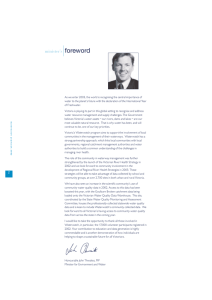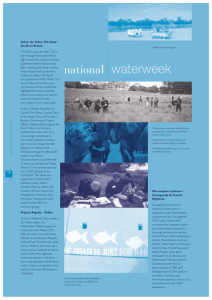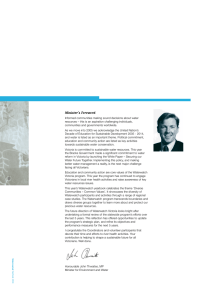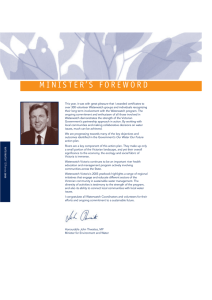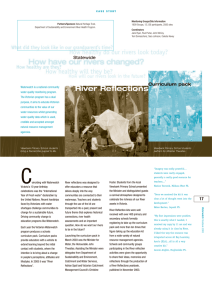2006/07 Mallee
advertisement
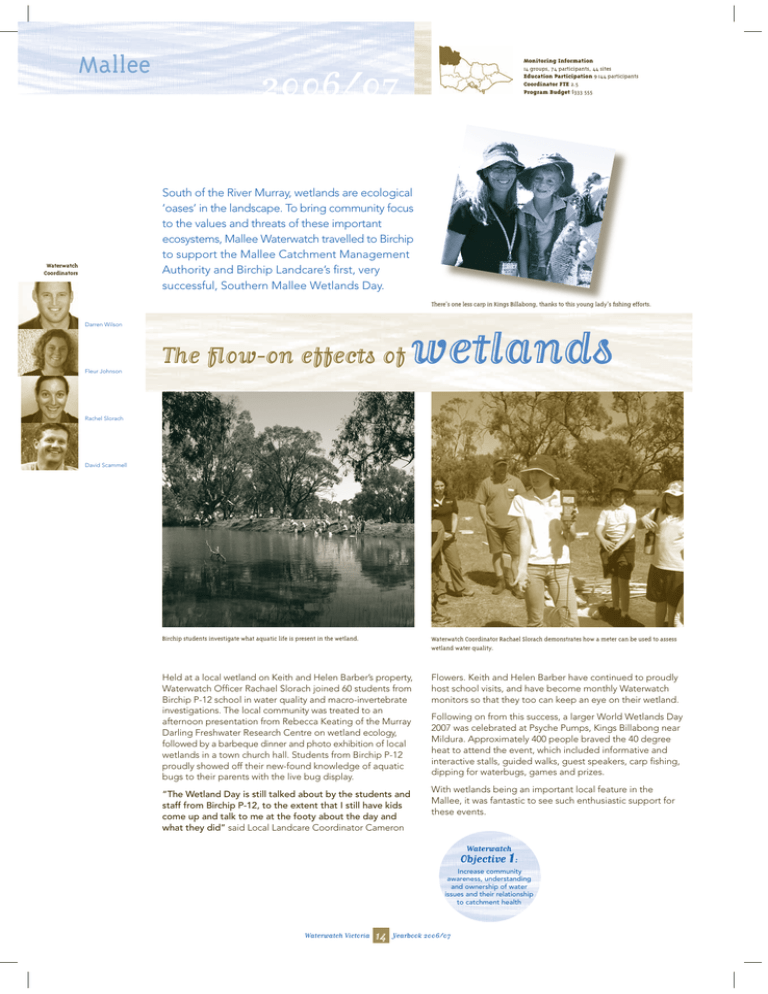
Mallee Monitoring Information 14 groups, 74 participants, 44 sites Education Participation 9 144 participants Coordinator FTE 2.5 Program Budget $333 555 2006/07 South of the River Murray, wetlands are ecological ‘oases’ in the landscape. To bring community focus to the values and threats of these important ecosystems, Mallee Waterwatch travelled to Birchip to support the Mallee Catchment Management Authority and Birchip Landcare’s first, very successful, Southern Mallee Wetlands Day. Waterwatch Coordinators There’s one less carp in Kings Billabong, thanks to this young lady’s fishing efforts. Darren Wilson The flow-on effects of Fleur Johnson wetlands Rachel Slorach David Scammell Birchip students investigate what aquatic life is present in the wetland. Waterwatch Coordinator Rachael Slorach demonstrates how a meter can be used to assess wetland water quality. Held at a local wetland on Keith and Helen Barber’s property, Waterwatch Officer Rachael Slorach joined 60 students from Birchip P-12 school in water quality and macro-invertebrate investigations. The local community was treated to an afternoon presentation from Rebecca Keating of the Murray Darling Freshwater Research Centre on wetland ecology, followed by a barbeque dinner and photo exhibition of local wetlands in a town church hall. Students from Birchip P-12 proudly showed off their new-found knowledge of aquatic bugs to their parents with the live bug display. Flowers. Keith and Helen Barber have continued to proudly host school visits, and have become monthly Waterwatch monitors so that they too can keep an eye on their wetland. “The Wetland Day is still talked about by the students and staff from Birchip P-12, to the extent that I still have kids come up and talk to me at the footy about the day and what they did” said Local Landcare Coordinator Cameron Following on from this success, a larger World Wetlands Day 2007 was celebrated at Psyche Pumps, Kings Billabong near Mildura. Approximately 400 people braved the 40 degree heat to attend the event, which included informative and interactive stalls, guided walks, guest speakers, carp fishing, dipping for waterbugs, games and prizes. With wetlands being an important local feature in the Mallee, it was fantastic to see such enthusiastic support for these events. Waterwatch Objective 1: Increase community awareness, understanding and ownership of water issues and their relationship to catchment health Waterwatch Victoria 14 Yearbook 2006/07 O Water donors see firsthand what aquatic life has colonised the inundated floodplain areas. H Landcare Coordinator Tony Smith looks on as a Landcare member nets for macro-invertebrate life. A ow do you thank 120 Mallee locals for donating 5.6 gigalitres of unused water allocations towards the emergency watering of stressed red gums? You organise a Thankyou Day at Nangiloc, allowing water managers to personally meet and thank donors, and celebrate how their water was supporting floodplain life. Mallee Waterwatch’s live water bug display, sampled from within the newly inundated wetland areas, demonstrated the positive ecological response to the community’s actions. ssessing salinity during the drought has attracted new Waterwatch monitors in the Mallee. One volunteer is Landcare Coordinator Tony Smith, who is monitoring two sites at Woorlong for the Yelta Landcare program and as part of the Bureau of Rural Science’s Community Stream Sampling Project. The collected data will help to guide priorities for future investment in salinity management across the Murray-Darling basin. Locally, data will help catchment managers and landholders to plan water management projects within the region. Waterwatch Objective 2 4 3 3: Increase community involvement in water management decisions and gain community commitment to action in addressing waterway and catchment issues The Hattah Lakes are a significant ecological asset of the Murray River system. 5 Waterwatch Objective uyen Secondary students stepped outside of the classroom to see for themselves the ecological response of the Hattah-Kulkyne Lakes to environmental flows. Waterwatch supported the teachers to test water quality at the pumping site, and assess the rich diversity and abundance of macro-invertebrates in the lake system. The hands-on learning experience allowed the students to form their own scientific opinions of the environmental flow event, at a time when the project was receiving some negative press. 2: 1 Involve communities monitoring their local waterways to collect and provide data which is credible, accepted and used Secondary students collect data to better understand the ecological response of the environmental flows. Waterwatch Objective 5: Provide school learning opportunities and be an integral part of the curriculum W Management of the majestic Kings Billabong is enhanced by effective community partnerships. aterwatch monitoring has helped the Friends of Kings Billabong to strengthen their partnership with catchment managers. Five years of fortnightly data collected by Bernadette Chaplin has helped the group to learn more about the local wetland area. This contributes directly to management projects including the Draft Kings Billabong Wildlife Reserve Riverine Protection Plan. The Group brings local knowledge, skills and experience to long-term planning of the Reserve, which may not be otherwise available to managers. Waterwatch Objective 4: Establish and maintain effective partnerships between the community and catchment managers Other outstanding highlights and achievements Additional funds received through the Bureau of Rural Science’s Community Stream Sampling program. Employment of an additional Waterwatch Officer . New multipurpose trailer for salinity education, water quality education, field days, shows and special events. Partners/Sponsors Mallee Catchment Management Authority, Lower Murray Water, National Action Plan for Salinity and Water Quality, Bureau of Rural Sciences, Sunraysia Marine. Photos courtesty of Mallee Waterwatch and Mallee Catchment Management Authority. Waterwatch Victoria 15 Yearbook 2006/07
